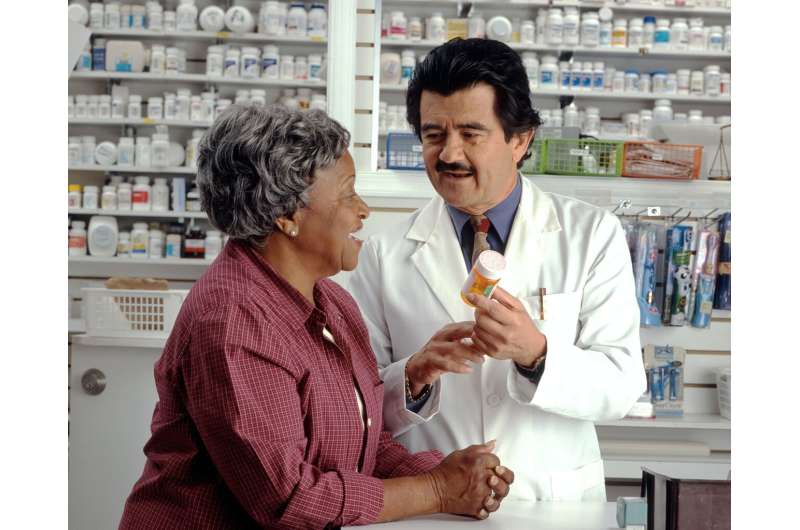
If pharmacists had a larger role in prescribing medications to control blood pressure, they could prevent more than 15 million heart attacks, nearly 8 million strokes and more than 4 million cases each of angina and heart failure in the U.S. over 30 years, according to a new Virginia Commonwealth University-led study.
The study, “Cost-Effectiveness of Pharmacist Prescribing for Managing Hypertension in the United States,” which is published today in JAMA Network Open, details how pharmacists’ ability to treat patients with hypertension directly could have both a positive impact on Americans’ health and quality of life and a significant economic impact on the U.S. health care system.
The study is among the first to explore the economics of pharmacist prescribing to improve blood pressure control.
The research team, led by corresponding author Dave Dixon, Pharm.D., of the VCU School of Pharmacy, found that the U.S. health care system could save more than $1.1 trillion over 30 years, a cost savings of $10,162 per patient. Moreover, the study’s authors found that over 30 years, patients could regain more than 30 million “quality-adjusted life years,” or years where their quality of life is significantly higher than it would have been if they were to have a health emergency.
Dixon, the Nancy L. and Ronald H. McFarlane Professor of Pharmacy and chair of the Department of Pharmacotherapy and Outcomes Science at the VCU School of Pharmacy, said these findings support measures that could increase access to care for millions across the country.
“Being that hypertension affects so many Americans—we’re talking about over 100 million people in the U.S.—I think the impact is tremendous because everybody knows somebody with high blood pressure,” said Dixon, who serves as a core faculty member and former director of the Center for Pharmacy Practice Innovation at the VCU School of Pharmacy. “It’s one of the leading causes of heart disease and kidney failure in the world.”
More than 95% of Americans live within 5 miles of a community pharmacy, a 2022 study in the Journal of the American Pharmacists Association found. And according to the Centers for Disease Control and Prevention, patients visit their community pharmacist 12 times more frequently than their primary care provider. As the U.S. faces a shortage of primary care professionals, Dixon said pharmacists could bridge that gap.
“Pharmacists’ role as health care providers tends to be underused in the community, and this is really about how pharmacists can provide for their communities in a way that improves access to care for hypertension,” said Dixon, who also serves as an affiliate professor of internal medicine in the Division of Cardiology at the VCU School of Medicine.
Most states currently give pharmacists prescribing privileges; however, current federal laws make it difficult for pharmacists to receive reimbursement for the clinical services they provide.
“Although pharmacists currently have some type of prescribing privileges in 49 states and Washington, D.C., they are not recognized as providers under the Social Security Act,” Dixon said. “This is one of the major barriers to implementing these life-saving—and cost-saving—measures for patients.”
The $1.1 trillion in health care savings over 30 years that Dixon and his team identified stem from preventive measures, such as educating patients on high blood pressure and prescribing antihypertensive medication, as well as from helping patients better manage their blood pressure. The ability to offer these services could mean a reduction in cardiovascular emergencies, which is crucial given the increasing mortality rates around hypertension.
From 2010-19, there was a 23.1% increase in hypertension-related mortality, according to a 2022 study from the Journal of the American Heart Association. It could also address poor outcomes for racial and ethnic minority groups, Dixon said. For individuals ages 35-64, Black patients had the highest rates of death due to hypertension of any racial or ethnic group in the U.S., according to a 2020 study in the journal Hypertension.
As Dixon and his co-authors state in the study, “Pharmacist-led interventions have been shown to significantly improve blood pressure control among Black individuals and individuals of racial and ethnic minoritized groups.”
More information:
Dave L. Dixon et al, Cost-Effectiveness of Pharmacist Prescribing for Managing Hypertension in the United States, JAMA Network Open (2023). DOI: 10.1001/jamanetworkopen.2023.41408
Journal information:
Journal of the American Heart Association
,
JAMA Network Open
,
Hypertension
Source: Read Full Article
